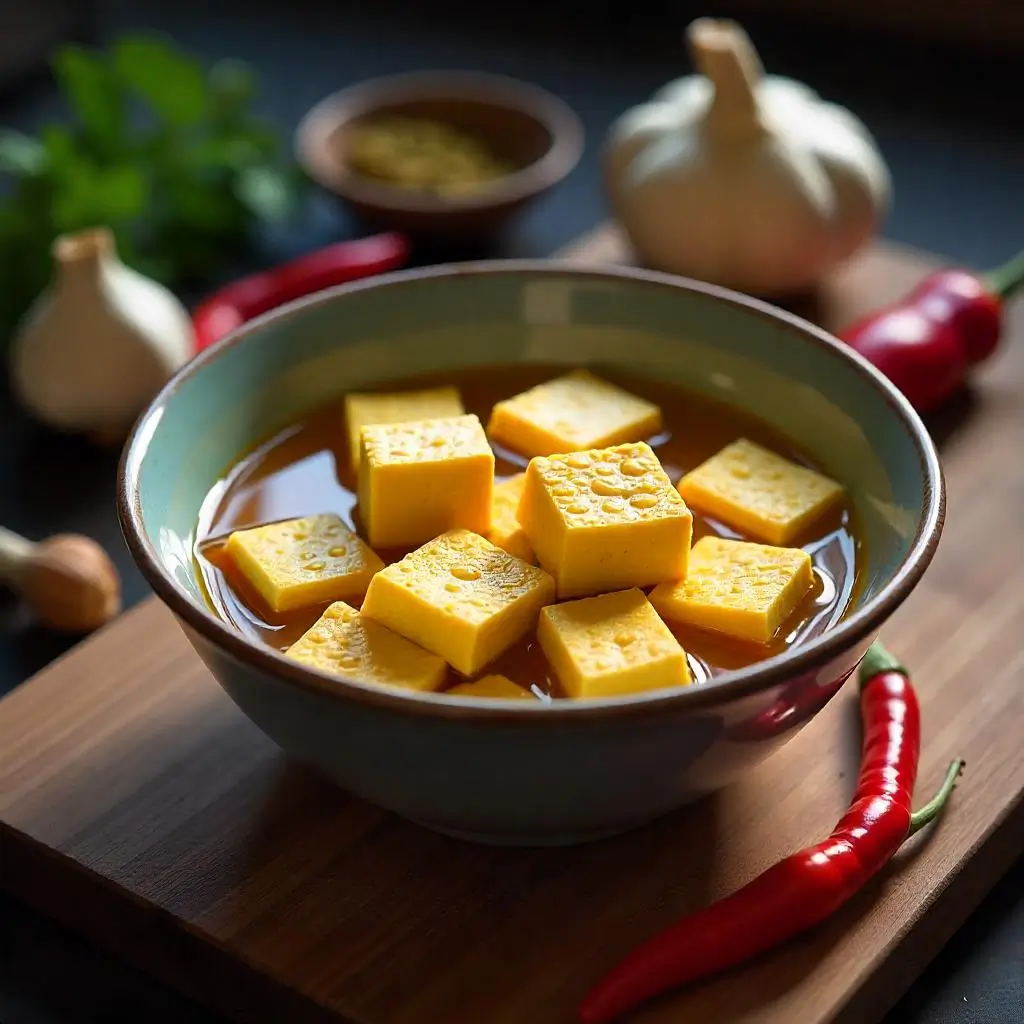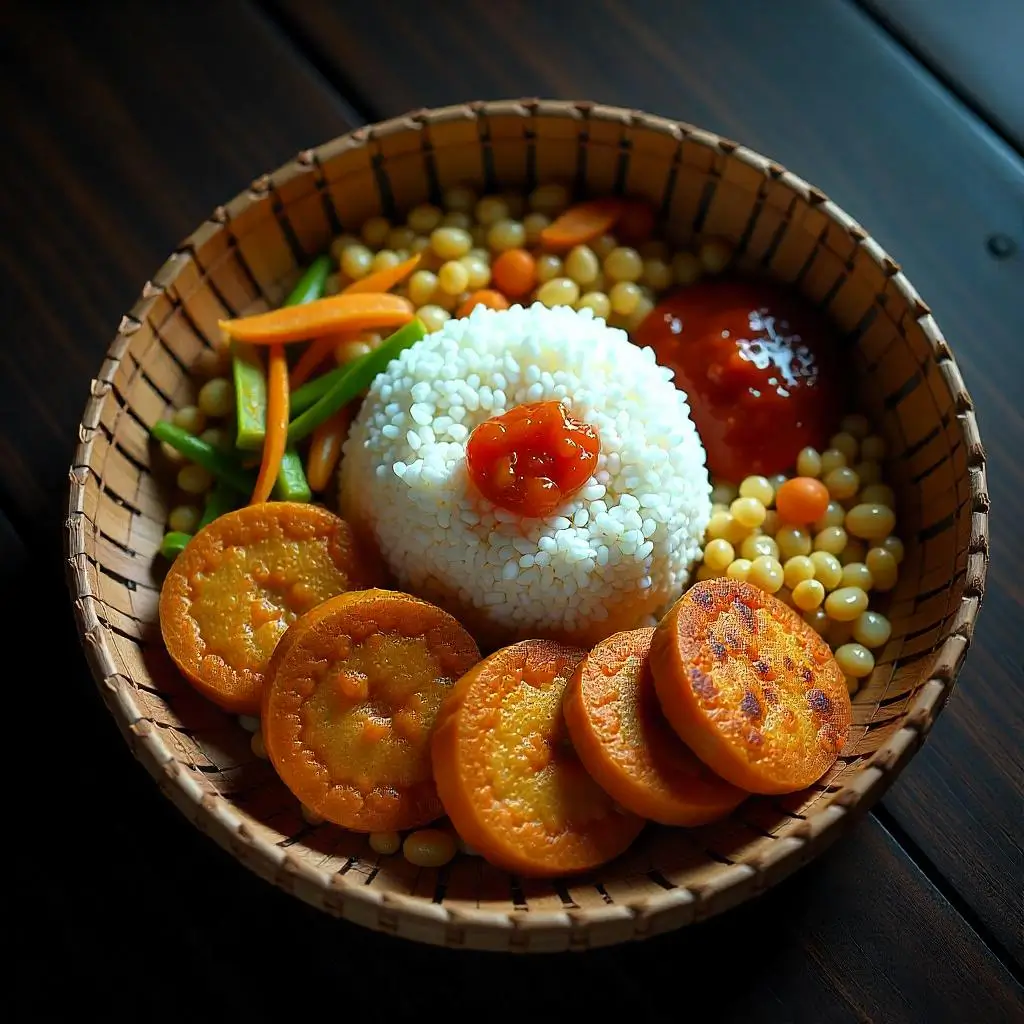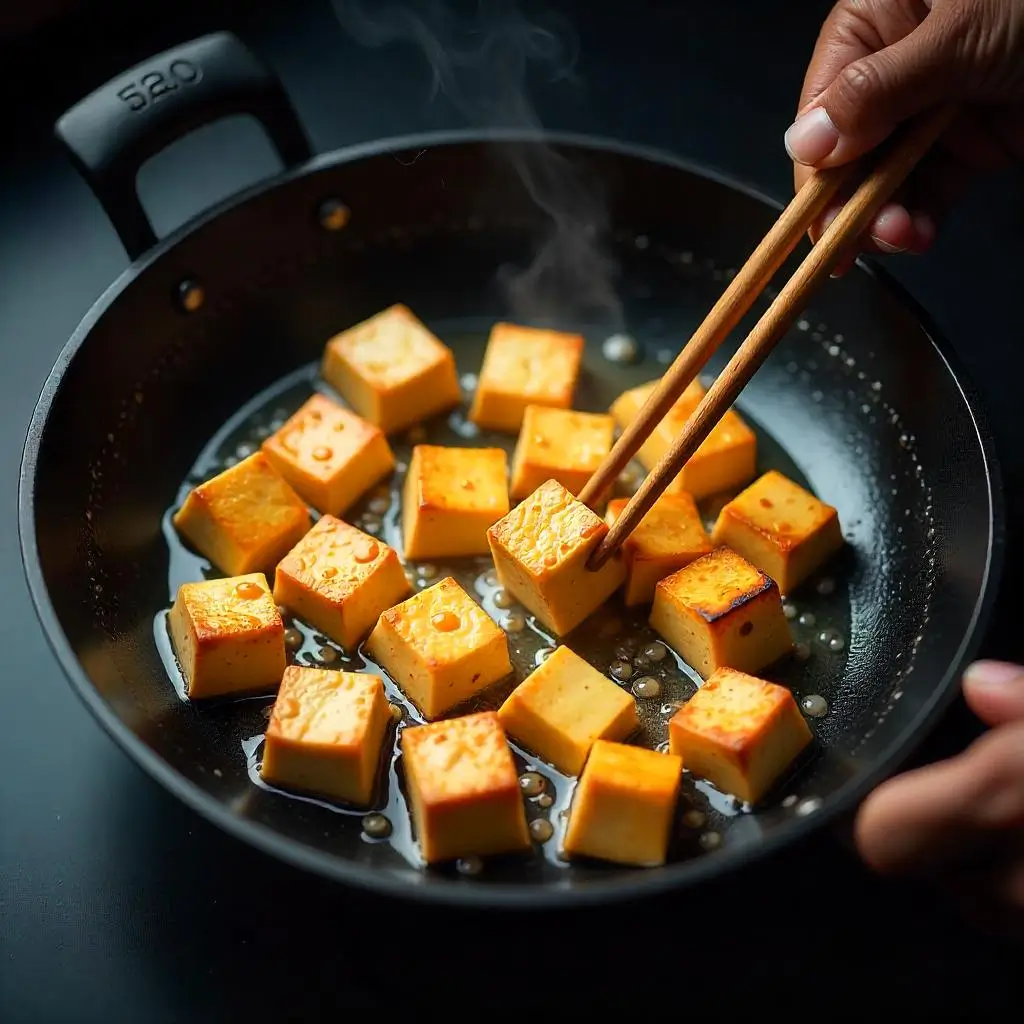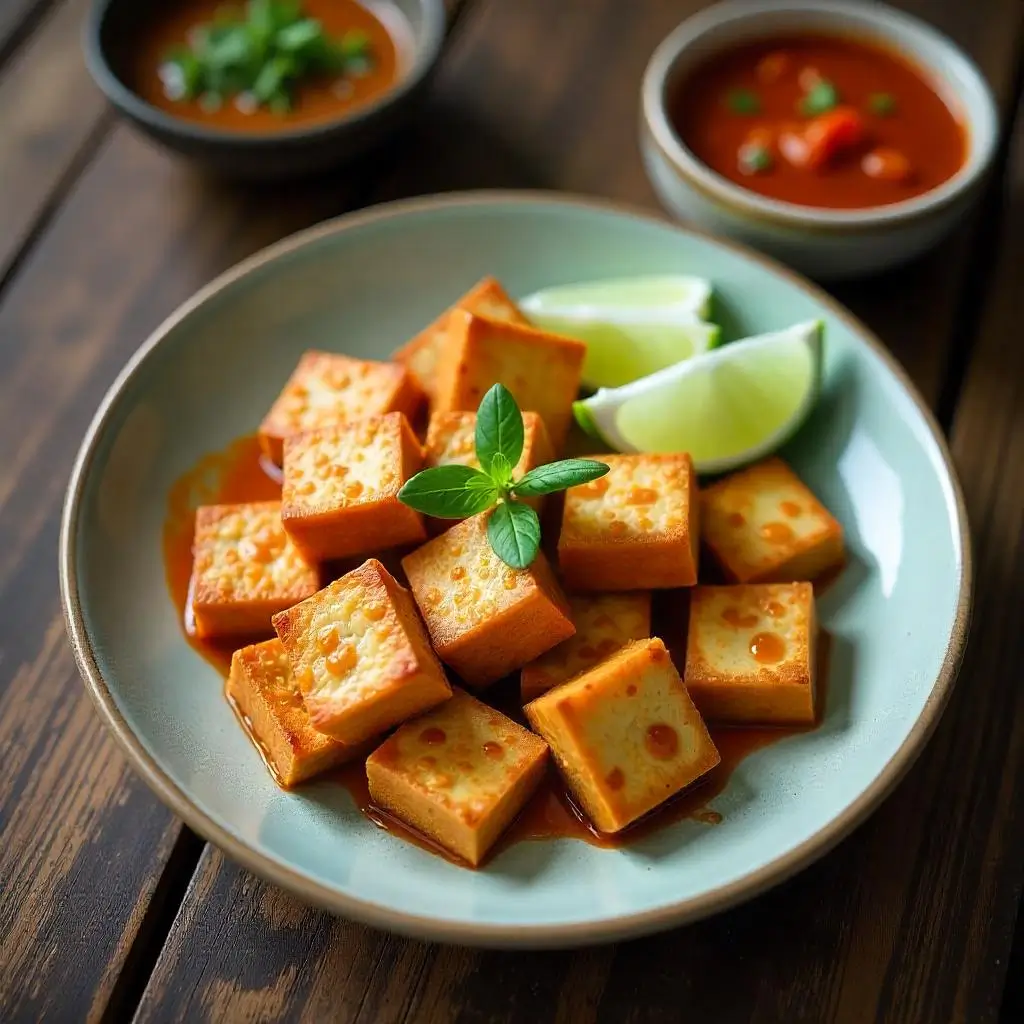Have you ever craved that perfect combination of crispy-on-the-outside, silky-on-the-inside comfort food that satisfies your soul? Furthermore, have you been searching for an authentic Southeast Asian dish that’s naturally vegan and incredibly easy to make? If so, then Tahu Goreng is about to become your new obsession.
This Indonesian street food gem has been captivating taste buds across temple fairs in Singapore, bustling markets in Malaysia, and vibrant food stalls throughout Indonesia for generations. What makes it truly special, however, is that it was born vegan – no adaptations or substitutions necessary. Unlike many traditional dishes that require modifications for plant-based diets, Tahu Goreng celebrates tofu in its most glorious form.
Picture this: golden-brown cubes of perfectly fried tofu, boasting a magnificently crispy exterior that gives way to the creamiest, most luxurious interior you can imagine. Moreover, it’s generously bathed in a complex, tangy-sweet sauce that balances the tartness of tamarind with the richness of ground peanuts and the aromatic warmth of toasted sesame seeds. Finally, it’s topped with refreshing cucumber julienne and crispy fried shallots that add the perfect textural contrast.
What’s even better? This restaurant-quality dish takes just 15 minutes from start to finish. Whether you’re a busy parent looking for a kid-friendly option (simply omit the chilies), a vegan food enthusiast seeking authentic flavors, or someone who appreciates naturally gluten-free dishes, Tahu Goreng delivers on every front.
Table of Content
- The Secret to Perfect Tahu Goreng
- Understanding the Flavor Profile
- Essential Ingredients and Preparation
- Step-by-Step Cooking Instructions
- Serving Suggestions and Variations
- Pro Tips for Perfect Tahu Goreng
- Nutrition
- Other recipes
The Secret to Perfect Tahu Goreng

The magic of authentic Tahu Goreng lies, first and foremost, in achieving that perfect textural contrast. Picture this: your teeth breaking through a magnificently crispy, golden exterior only to discover the silky, tender interior that melts on your tongue. Consequently, this isn’t just food; it’s an experience that transports you straight to the heart of Indonesia with every mouthful.
The foundation of exceptional Tahu Goreng starts, above all, with selecting the right tofu. Specifically, you’ll want to seek out a large block of semi-firm tofu. This variety holds its shape beautifully during the frying process while simultaneously maintaining that luxurious, creamy center we’re after. In fact, the semi-firm texture strikes the perfect balance, firm enough to develop a stunning crust yet soft enough to provide that contrasting interior texture.
While traditional deep-frying remains the preferred method for achieving restaurant-quality results, modern home cooks have discovered that an air-fryer alternative can produce remarkably similar results with less oil. Both methods have their merits, and ultimately, the choice often comes down to personal preference and available equipment.
Understanding the Flavor Profile
What elevates Tahu Goreng from simple fried tofu to culinary masterpiece is, undoubtedly, the complex, tangy-sweet sauce that accompanies it. This isn’t just any sauce – rather, it’s a carefully balanced symphony of flavors. In particular, it brings together the tartness of tamarind, the richness of ground peanuts, the warmth of toasted sesame seeds, and the aromatic punch of fried garlic and shallots.
The beauty of this dish lies, moreover, in its versatility. Traditional standard toppings include crisp cucumber julienne and golden fried shallots. However, creative cooks often experiment with alternative garnishes such as fresh bean sprouts, blanched kangkong (water spinach), or additional crispy fried garlic for extra flavor dimension.
For families with young children, the dish easily adapts by simply omitting the chili from the sauce preparation. Therefore, it becomes a genuinely kid-friendly option that introduces little ones to the wonderful world of Southeast Asian flavors without overwhelming heat.
Essential Ingredients and Preparation
For the Tofu:
- 1 large block semi-firm tofu
- Oil for deep frying
For the Sauce:
- 2 tablespoons tamarind paste
- 3 cloves garlic, minced
- 2-3 red chilies (optional, omit for children)
- 3 tablespoons palm sugar or brown sugar
- 2 tablespoons dark soy sauce
- 1 tablespoon light soy sauce
- 1/4 cup roasted peanuts, coarsely ground
- 2 tablespoons toasted sesame seeds
For Garnish:
- 1 cucumber, julienned
- 3-4 shallots, thinly sliced and fried until golden
- Additional roasted peanuts for sprinkling

Step-by-Step Cooking Instructions
Preparing the Garnishes
Begin by preparing your garnishes, as these components add both visual appeal and textural interest to the final dish. If you’re making your own fried shallots, first slice them thinly and then fry in oil over medium heat until they turn a beautiful golden brown and become crispy. Alternatively, high-quality store-bought fried shallots work perfectly and save considerable time.
Next, julienne your cucumber into thin, matchstick-sized pieces. This provides a refreshing, cooling element that balances the rich, warm flavors of the sauce beautifully.
For the peanuts, you have two options depending on your available equipment. If you have a mortar and pestle, coarsely pound the roasted peanuts until they’re broken into chunky pieces – this traditional method provides the most authentic texture. On the other hand, without a mortar, place the peanuts in a sealed plastic bag and gently crush them with a rolling pin or the flat side of a knife.
Subsequently, toast both the peanuts and sesame seeds in a dry pan over medium heat, stirring frequently until they become fragrant and lightly golden. This crucial step intensifies their nutty flavors significantly.
Creating the Perfect Sauce
The sauce represents the soul of Tahu Goreng, so therefore, take care with each step. Start by preparing your tamarind juice – rub the tamarind paste in warm water, then strain the mixture through a fine sieve to remove any seeds or fiber. As a result, you’re left with smooth, tangy tamarind water.
Heat a tablespoon of oil in a small pan and fry the minced garlic and chopped chilies until aromatic and lightly golden. This forms the flavor base of your sauce.
Meanwhile, in a separate bowl, combine the palm sugar, both soy sauces, and tamarind juice, stirring until the sugar completely dissolves. Add this mixture to the pan with the fried garlic and chilies.
Incorporate the toasted peanuts and sesame seeds into the sauce, then bring everything to a gentle boil. Allow the sauce to simmer and thicken slightly before removing from heat. The consistency should coat the back of a spoon but remain pourable.
Frying the Tofu to Golden Perfection
This step requires attention to both safety and technique. First, thoroughly pat the tofu dry using paper towels or a clean kitchen cloth. Any remaining moisture will cause dangerous oil splattering during frying.
Heat your oil in either a deep, heavy-bottomed pot or a wide, shallow pan. If using a shallow pan, ensure the oil reaches at least halfway up the height of your tofu block. The oil temperature should reach approximately 350°F (175°C) – test with a small piece of tofu; it should sizzle immediately upon contact.
Carefully lower the tofu into the hot oil and fry until golden brown on all sides, turning as needed. This typically takes 8-10 minutes total, depending on the size of your tofu block. The exterior should develop a deep, even golden color and sound hollow when tapped gently.
Finally, remove the tofu and drain on paper towels to remove excess oil.
Assembly and Presentation
Proper presentation elevates this humble dish into something truly special. Using a sharp knife, slice the fried tofu about 90% through its depth, creating portions that remain connected at the base. This makes sharing easier while maintaining the visual appeal of the whole block.
Spoon the warm sauce into the bottom of your serving plate, creating an attractive pool. Carefully place the sliced tofu on top of the sauce, allowing some sauce to seep between the cuts.
Garnish generously with the julienned cucumber and crispy fried shallots, creating an appealing contrast of colors and textures. Finally, sprinkle additional crushed peanuts over the top for extra crunch and visual appeal.

Serving Suggestions and Variations
Tahu Goreng works beautifully as an appetizer, side dish, or light main course. It pairs wonderfully with steamed jasmine rice, fresh vegetables, or as part of a larger Southeast Asian feast. The dish is best enjoyed immediately while the tofu remains crispy and the sauce is warm.
For those following specific dietary requirements, this recipe naturally accommodates gluten-free needs when using tamari instead of regular soy sauce. The absence of any animal products makes it perfect for vegan gatherings, while its mild heat level (when chilies are omitted) ensures it’s suitable for children.
This authentic Indonesian treasure proves that the most memorable dishes often emerge from the simplest ingredients. Through technique, care, and understanding of flavor balance, they transform into something truly extraordinary.
Pro Tips for Perfect Tahu Goreng
Tofu Selection and Preparation Tips
- Choose the right firmness: Semi-firm tofu is ideal – firm enough to hold its shape but soft enough for that creamy interior
- Pat dry thoroughly: Use paper towels or clean kitchen towels to remove ALL moisture. Wet tofu causes dangerous oil splatter
- Room temperature works best: Let tofu sit at room temperature for 15 minutes before frying for even cooking
- Score lightly: Make shallow cuts on the surface to help oil penetrate and create extra crispy edges
Oil and Frying Tips
- Test oil temperature: Drop a small piece of bread – it should sizzle immediately and turn golden in 60 seconds
- Don’t overcrowd: Fry one block at a time to maintain oil temperature
- Use a splatter screen: Protects against oil splatter while allowing steam to escape
- Save the oil: Strain and store frying oil for future use (up to 3 times)
Sauce Mastery Tips
- Toast your spices: Lightly toast ground peanuts and sesame seeds for deeper flavor
- Strain tamarind properly: Use a fine-mesh sieve to get smooth tamarind juice without pulp
- Balance is key: Taste and adjust – add more palm sugar for sweetness, tamarind for tang
- Consistency matters: Sauce should coat a spoon but still be pourable when warm
Assembly and Serving Tips
- Warm plates: Serve on slightly warmed plates to keep everything at the perfect temperature
- Slice strategically: Cut 90% through so pieces stay connected but are easy to separate
- Layer flavors: Put sauce on the bottom so it doesn’t hide the beautiful golden tofu
- Fresh garnishes: Add cucumber and fried shallots just before serving for maximum crunch

Storage and Make-Ahead Tips
- Sauce keeps well: Make sauce up to 2 days ahead – it actually improves in flavor
- Reheat gently: Warm sauce over low heat, adding a splash of water if too thick
- Crispy tofu doesn’t wait: Fry tofu just before serving for best texture
- Leftover transformation: Crumble leftover tofu over salads or rice bowls
Troubleshooting Common Issues
- Oil splatter problem: Tofu wasn’t dry enough – always pat completely dry
- Soggy exterior: Oil temperature too low – maintain 350°F throughout cooking
- Sauce too thick: Add warm water or tamarind juice, one tablespoon at a time
- Too spicy for kids: Always taste sauce before adding chilies – you can’t take them out once added
Flavor Variations to Try
- Add lemongrass: Bruise a stalk and add to oil while frying for aromatic flavor
- Coconut twist: Replace some tamarind juice with coconut milk for richness
- Extra crunch: Add toasted coconut flakes to the garnish mix
- Herb boost: Finish with fresh cilantro or Thai basil for brightness

Nutrition
- Protein: 18g
- Calories: 385
- Carbs: 22g
- Fat: 28g
- Fiber: 4g
Other recipes

In conclusion, Tahu Goreng represents everything we love about Southeast Asian cuisine – simplicity, bold flavors, and incredible satisfaction in every bite. Moreover, this naturally vegan dish proves that you don’t need complicated ingredients or lengthy preparation times to create something truly special. Whether you’re serving it as a quick weeknight side dish or presenting it as part of an elaborate Indonesian feast, Tahu Goreng never fails to impress.
Furthermore, the beauty of this recipe lies in its adaptability. You can easily adjust the spice level for children, experiment with different garnishes, or even try the air-fryer method for a healthier twist. Most importantly, once you master the technique of achieving that perfect crispy exterior and silky interior, you’ll find yourself returning to this recipe time and time again.
So next time you’re craving authentic Indonesian flavors, remember that this golden treasure is just 15 minutes away. Give Tahu Goreng a try, and discover why it’s been captivating taste buds across Southeast Asia for generations. After all, the best culinary adventures often begin with the simplest of dishes

Tahu Goreng (Indonesian Deep Fried Tofu): The Ultimate Crispy Vegan Delight
Description
“Discover how to make Tahu Goreng, a crispy and savory Indonesian fried tofu dish that’s perfect as a snack or side. Easy, delicious, and packed with flavor!”
Ingredients
For the Tofu:
For the Sauce:
For Garnish:
Instructions
- Prepare garnishes: Julienne cucumber and fry sliced shallots until golden. Toast peanuts and sesame seeds in a dry pan until fragrant. Coarsely grind peanuts.
- Make tamarind juice: Mix tamarind paste with warm water, strain through fine sieve to remove seeds and pulp.
- Prepare sauce: Heat 1 tablespoon oil in small pan. Fry garlic and chilies until aromatic. Mix sugars, soy sauces, and tamarind juice in bowl. Add to pan with garlic. Stir in ground peanuts and sesame seeds. Simmer until thickened. Set aside.
- Prepare tofu: Pat tofu completely dry with paper towels to prevent oil splatter.
- Heat oil: Heat oil in deep pot or wide pan to 350°F (175°C). Oil should reach halfway up tofu block.
- Fry tofu: Carefully add tofu to hot oil. Fry 8-10 minutes, turning occasionally, until golden brown on all sides. Drain on paper towels.
- Assemble: Slice tofu 90% through depth. Spoon warm sauce on serving plate. Place sliced tofu over sauce. Garnish with cucumber, fried shallots, and crushed peanuts.
Notes
- For kids: Omit chilies from sauce for mild flavor
Air fryer option: Cook at 380°F for 12-15 minutes, flipping halfway
Make ahead: Sauce can be prepared 1 day in advance and reheated
Storage: Best enjoyed immediately while tofu is crispy
Gluten-free: Use tamari instead of soy sauce